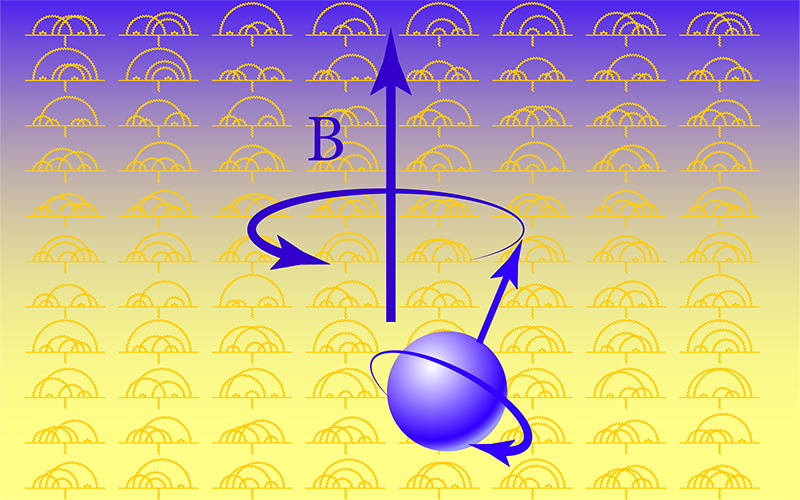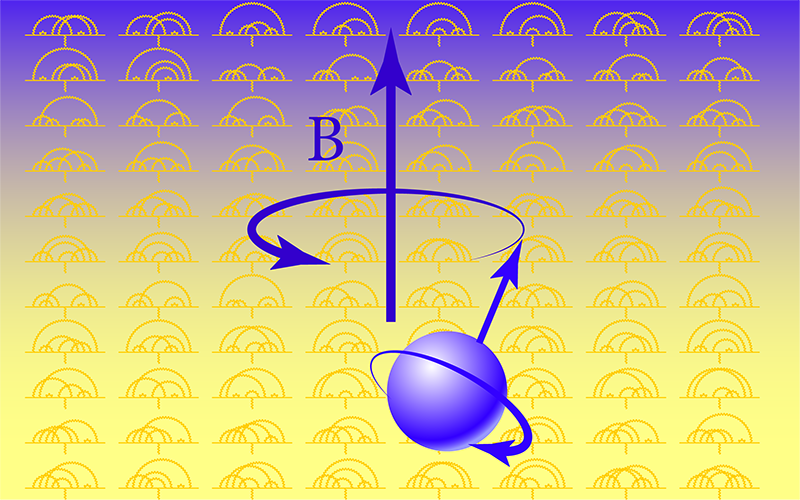Searching for New Physics with the Electron’s Magnetic Moment
Despite its remarkable successes, the standard model of particle physics clearly isn’t complete—dark matter, dark energy, and the matter–antimatter asymmetry of the Universe are some of its most flagrant deficiencies. Experimenters thus eagerly search for anomalies that could provide hints on a theory that could complete or replace the standard model. The electron is a key player in this quest: its magnetic moment is both the most precisely measured elementary-particle property and the most accurately verified standard model prediction to date. New measurements by Gerald Gabrielse’s group at Northwestern University in Illinois [1] have determined the value of the electron’s magnetic moment 2.2 times more accurately than the previous best estimate, which was obtained in 2008 [2]. The result paves the way for much larger accuracy improvements in the next few years, offering tantalizing prospects for using these measurements to search for physics beyond the standard model.
New physics starts at the next digit of precision, according to a physicists’ adage—for which the history of the electron magnetic moment offers a great illustration. After experiments revealed that the electron had spin, Paul Dirac offered a formal description of the electron spin with his famous relativistic equation. He predicted that the electron g factor—a dimensionless quantity relating the particle’s magnetic moment to its angular momentum—should be 2. But in 1947, the high-precision experiments of physicists Polykarp Kusch and Henry Foley revealed that g is slightly larger than 2. This “anomalous” magnetic moment was explained by physicist Julian Schwinger, who showed that a value slightly larger than 2 could be obtained by including a quantum-mechanical correction in the g calculation. Schwinger’s calculation laid the foundation for the theory of quantum electrodynamics (QED). Ever since, the electron’s magnetic moment has played a key role in tests of QED and of the standard model.
But how can an elementary particle’s magnetic moment be used to test the standard model? The answer is related to the fact that, according to quantum physics, the vacuum is teeming with virtual particles that pop in and out of existence. These particles can interact with a given particle, such as an electron or a muon, modifying its response to a magnetic field and thus affecting its magnetic moment and g factor. Theorists can calculate the expected value of a particle’s g factor by accounting for the interaction with the elementary particles foreseen by the standard model. Any deviation of the experimental value from predictions may reveal a missing piece in the model’s repertoire of particles or interactions (Fig. 1). For the electron, a deviation from the predictions could even imply that the electron isn’t an elementary particle but has an internal structure.
Currently, the most intriguing enigma in this field is the persistent mismatch between theory and experiment for the magnetic moment of the muon—a discrepancy that has now reached a 4.2- 𝜎 statistical significance [2]. If this mismatch is the signature of new physics, it should also be observed on the electron. Given the 207 times lighter mass of the electron, the effect on the electron would be about 40,000 smaller than the effect on the muon. The new measurement by Gabrielse’s group reaches a relative accuracy for the electron magnetic moment of 0.13 parts per trillion (ppt)—more than 3000 times smaller than that achieved for the muon [2]. The obtained value result is consistent with the 2008 experiment, performed at Harvard University by a team also led by Gabrielse, which achieved a 0.28-ppt accuracy [3].
The key idea for a high-precision magnetic-moment determination is to obtain it from the measurement of the ratio of two frequencies. The magnetic moment of the electron is proportional to its spin and g factor. In a constant magnetic field, the deviation of g from 2, or “g-2,” is given by va/vc, where vc is the cyclotron frequency (at which the electron spins around the field), and va = vc − vs (where vs is the electron spin frequency). One advantage of this approach is that both va and vc are—to a first approximation—proportional to the magnetic field, so the field dependence cancels out (assuming the field is stable over the measurement time). This cancellation makes the experiment less sensitive to slow field drifts. In addition, since va and vc differ by only 1 part in 103, an accuracy of 1 part in 1010 on the measurement of both frequencies results in a precision of 1 part in 1013 in their ratio, and thus in g.
The Northwestern University setup—a next-generation update of the one used in the 2008 Harvard University experiment—is a unique feat of engineering. In the scheme, a single electron is kept in a so-called Penning trap under a constant, 5-T magnetic field and cooled to temperatures at which the electron’s cyclotron motion is quantized, with the electron initially sitting in the ground state. Next, va and vc are determined by observing “quantum jumps” of the electron between the lowest-energy levels. With a special trick—the addition of a small magnetic-field gradient—the setup allows the researchers to perform quantum nondemolition (QND) detection, a measurement that detects the quantum jumps without affecting the electron quantum state, which is key to reducing the measurement uncertainty.
The achieved measurement accuracy stems from several major technical improvements. First, the setup boosts the stability and homogeneity of the magnetic field through ingenious suspension and cooling schemes. Second, a new design of the trapping cavity allows for precise control of the electron’s axial motion and strongly inhibits spontaneous-emission transitions between the electron quantum levels, which would broaden the transition line shapes and thus reduce the precision of frequency determination. Finally, the researchers reduced systematic biases due to shifts of the cyclotron frequency induced by the coupling of the cyclotron motion to resonant modes of the trapping cavity. By characterizing the frequencies and “quality factors” of each of 72 contributing cavity modes, the researchers could account for such shifts.
The Northwestern University team’s achievement is a triumph for fundamental physics, one that enables an unprecedently precise test of QED and confirms that the electron is an elementary particle. The ability to use the measurement for testing the standard model prediction for the electron’s g-2 is currently hampered by the fact that the prediction accuracy depends on the value of the fine structure constant 𝛼. Unfortunately, there is a 5.5- 𝜎 discrepancy between the two most accurate measurements of 𝛼, performed by a team at the University of California, Berkeley, [4] and by my group at Sorbonne University, France [5]. Both groups are planning new measuring campaigns to resolve this discrepancy. Finally, the new setup has huge potential for further improvement. In the near future, it is reasonable to expect that the electron g-2 measurements will reach comparable sensitivity to new physics to that of the muon g-2 measurements that revealed the tantalizing 4.2- 𝜎 tension with the standard model [2]. All these developments indicate that the electron has never been so well poised to open a window on new physics.
References
- X. Fan et al., “Measurement of the electron magnetic moment,” Phys Rev. Lett. 130, 071801 (2023).
- B. Abi et al., “Measurement of the positive muon anomalous magnetic moment to 0.46 ppm,” Phys. Rev. Lett. 126, 141801 (2021).
- D. Hanneke et al., “New measurement of the electron magnetic moment and the fine structure constant,” Phys. Rev. Lett. 100, 120801 (2008).
- R. H. Parker et al., “Measurement of the fine-structure constant as a test of the standard model,” Science 360, 191 (2018).
- L. Morel et al., “Determination of the fine-structure constant with an accuracy of 81 parts per trillion,” Nature 588, 61 (2020).





